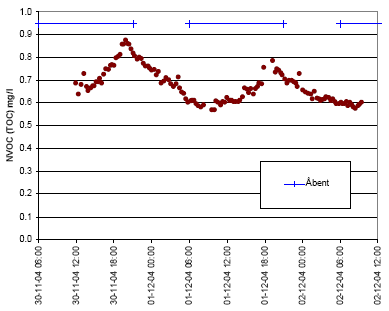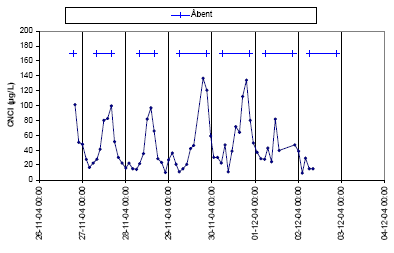Screening af bassinvand for kemiske biprodukter
Summary and Conclusions
Screening of disinfection-by-products in swimming pool water including investigations of factors of importance for their occurrence.
Background and objective
A number of disinfection-by-products are formed in swimming pool water from reactions of disinfecting active chlorine with organic material released from the pool guests.
Formation of trihalomethanes in particular has attracted public interest, and authorities in Denmark and other countries have defined limit values for the concentration of trihalomethanes based on single point measurements. The type of by-product and its concentration is variable and depends on the human load of the pool and the efficiency of the water treatment process. The current investigation has been put forward in order to identify possible disinfection-by-products other than trihalomethanes, and to analyse the temporal variation of by-products in different types of pools over a weekly period.
The investigation
On-line measurements of total organic compounds (TOC) and volatile organic compounds have been carried out in two Danish swimming pools in campaigns up to a week long during which diurnal variations have been analysed. In addition, point measurements were done on a number of samples from Danish swimming pools.
Main conclusions
- Apart from trihalomethanes, identified compounds comprise cyanogen chloride and dichloroacetonitrile in almost all samples.
- Cyanogen chloride was detected in very high concentrations (>100 μg/L) in many occassions.
- The data material cannot be used to either demonstrate or discard a correlation between trihalomethanes and cyanogen chloride due to large temporal variations and temporal dependency. The obtained data indicate a relationship between high TOC concentrations and elevated concentrations of disinfection by-products.
- Based on actual observations of temporal variations of by-products, it can be concluded that the concentration levels exhibit a pronounced temporal variation, in some cases from 10 to over 160 μg/L during the same day. This is not accounted for in the current water quality surveillance. On-line measurements are required in order to survey temporal variations, and in order to establish criteria for taking out representative samples as a part of the routine control program for swimming pool water.
- A number of hypotheses regarding the effect of water treatment on the concentration levels. These can be used as a basis for further investigations aiming at minimising the occurrence of disinfection by-products in pool water.
- Single point measurements of water quality parameters should be used with great caution for evaluation of water quality and treatment technologies.
- The accomplished investigations have revealed a demand for clarification of the following questions:
- How can guidelines that take the large diurnal variations into account be defined for routine control of swimming pool water.
- Which supplemental treatment methods and technologies are capable of minimising the formed by-products.
- Is there a need for regulating the maximum levels of disinfection by-products other than THMs, e.g. cyanogen chloride, in swimming pool water?
Project results
The results demonstrate a clear diurnal variation of the amount of total organic carbon (TOC) with an increase during opening hours of 40 to 90 %.

Figur 0.1 Measurements of temporal variation of TOC in Herning Swimming Pool.
Two compounds, dichloracetonitrile and cyanogen chloride, follow the temporal variation in TOC, and therefore the concentrations of these compounds are highest when the pools close down at night. Formation of THM is temporarily shifted so that the concentration increases during the night and is at its maximum at opening time.
As can be seen below, the temporal variation of cyanogen chloride is very large. The measured concentrations can be 10 to 16 times higher at closing time compared to opening time. In this case point measurements are not very valuable.

Figur 0.2 Diurnal variation of cyanogen chloride in Herning Swimming Pool.
The effect of water treatment steps differ from compound to compound. During treatment with ultraviolet light (UV) there is an increase in the concentration of cyanogen chloride, observed immediately at the outlet of the UV reactor.
In a number of facilities the concentration of chloroform is higher at the outlet of activated charcoal filters compared to the filter inlets whereas in most cases charcoal filters are able to remove or reduce cyanogen chloride and dichloroacetonitrile.
Version 1.0 Oktober 2007, © Miljøstyrelsen.